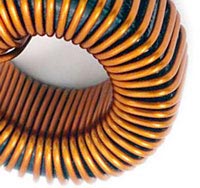Question: What is a ferrite core?
Answer: Ferrite cores are dense, homogeneous ceramic structures. They are made by mixing iron oxide with one or more metal such as manganese, zinc, nickel, or magnesium. Ferrites have high electrical resistivity and low eddy current losses over a wide frequency range. The characteristics of ferrites make them ideal for use in applications such as high-frequency transformers and adjustable inductors. Ferrites come in many different types of materials.
Question: What is disaccommodation?
Answer: When discussing ferrite cores, disaccommodation refers to the reduction of permeability with time after a core is demagnetized. Demagnetization can happen by heating above the Curie point. Mechanically shocking the core is another way to cause demagnetization.
Question: Why are core losses larger than calculated?
Answer: The structure is assumed homogeneous when the core losses are being calculated. However, this is not the case. Leakage flux occurs at the mating surfaces when core halves are mated. Leakage flux results in gap losses that contribute to the total losses.
Question: What is the difference between nickel-zinc and manganese-zinc ferrites?
Answer: Manganese-zinc ferrites have a high permeability. Nickel-zinc ferrites have a low permeability.
Question: Why are ferrite cores flat-ground?
Answer: Ferrite cores are flat-ground because of the uneven surface produced during the firing process.
Toroids
- Toroids and Modern Technology
the use of toroids provides higher efficiency which is perfect for stray magnetic field sensitive circuitry.
- Toroids and Practical Applications
- Electromagnetics and Toroids

